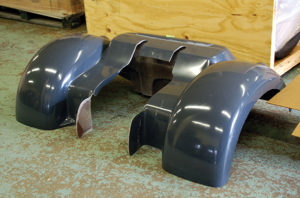By Elizabeth Bokfi
Amputation surgery is life-altering. Regardless of how quickly you navigate the emotional roller coaster to acceptance, for some, the effects may be more profound. For motorcyclists, losing a limb presents unique challenges. If you wish to continue motorin’, read on.
THE BASIC THREE-WHEELER
One of the simplest ways to stay in the wind would be to transition into a three-wheeled application called a trike. Two configurations of three-wheeled motorcycles are available: the tadpole (two wheels out front, one behind) and the more common delta (one wheel out front, two behind). A trike eliminates the challenge of having to balance the bike at stops and, in certain cases, offers an automatic transmission option, eliminating having to shift gears with your toes.
CAN-AM BY BOMBARDIER RECREATIONAL PRODUCTS (BRP)
Possibly two of the most recognized trikes on the road today are Can-Am’s Ryker and Spyder. With a tadpole configuration, the entry level Ryker can get you back in the wind at a starting price of $8,499. Its two models, a 600 and 900, feature automatic transmissions, two- and three-cylinder engines, and electronic ignition and throttle control; however, if long-haul is more your game, you can step up to a Spyder. At considerably higher costs, its three classes offer more cargo area, traction control, and more customizable options.
HARLEY-DAVIDSON TRI GLIDE ULTRA AND FREEWHEELER
There’s a niche market for three-wheelers. With emphasis on handling stability and touring comfort, Harley-Davidson entered that market in 2009 with the Tri Glide Ultra Classic–the company’s first manufactured trike model since its Servi-Car. It is the “couch” of comfort when it comes to trikes. Although it still has a manual transmission, the model now features electric-powered reverse—a handy thing to have if you are a leg amputee. If a sporty look is more your style, Harley-Davidson’s Freewheeler is minus the back/armrest and beer box, giving it a stripped-down, sleek appearance. All this glam doesn’t come without a price, however, with the Tri Glide Ultra and Freewheeler starting at $36,099 and $28,099, respectively.
CONVERSION KITS
If a conversion kit is more your speed, Motor Trike and Lehman Trikes are recognized names in the trike conversion industry and specialize in converting Kawasaki, Honda, Harley-Davidson, and Victory motorcycles.

Many bolt-on trike conversion kits are manufactured today. Sometimes described as training wheels for motorcycles, Ghost Wheels is a kit that uses trailer wheels and a hydraulic system to engage and disengage the lock. The kit requires no modifications to the existing frame. The wheels lean with the bike when you do but lock in upright position when you slow to a stop. This gives the rider stability when needed, while providing the sensation of motorcycle freedom when cornering. Add an electronic shifter, and you’re on your way.
THE SIDECAR
The addition of a sidecar is another three-wheeled option. The third wheel adds stability but does not drive; you are essentially “rolling” the wheel alongside the motorcycle. One caveat—unless you install an electronic shifter, you will still need to shift gears with your left foot. That is, unless you move the shifter to the right side, in which case gearing becomes inverse. It can get a bit tricky though when you approach a stop and have to engage the front brake with your right hand and

rear brake with your foot between downshifting gears. Although not for everyone, with a few custom modifications, transferring the foot shifter to the right side of a motorcycle is an attainable option for left below-knee amputees.
GADGETS
Here are some add-ons for riders whose budgets fall on the conservative side.
Adaptive Shifters and Brakes
These products make clutching, shifting, and braking easier. Pingel offers an electric speed shifter kit that involves shifting with button controls mounted to the handlebar. Kliktronic offers an electric shifter and a braking system designed for riders who are unable to brake using their right foot. A two-lever system mounted to the handlebar allows the rider to brake using two hand levers for front and rear braking.
Heel-Toe Shifters
This adaptation enables you to easily shift with your heel rather than hooking your toes under the gearshift. Click downward with your heel on the front, top surface of the peg, or tap your heel on the back. Price range: $40-$200+.

LegUp LandinGear by Chopper Design
Having balance issues? At just under $4,000, Chopper Design’s motorcycle stabilization aid will help you keep your legs up. Once you slow to 5 mph or under, a small set of wheels manually or automatically deploy to help you balance your motorcycle. Accelerate to 6 mph and they retract. Several demonstration videos of this product are available at www.landingear.com.
Losing a limb does not have to mean your motorcycling days are over. For motorcycle stunt rider Ryan Suchanek of Edgerton, Wisconsin, the loss of his left leg below the knee, the result of a serious crash involving a vehicle and the motorcycle he was riding, only made him more determined to keep riding. “As soon as I could remember what I ate for breakfast that day, I was riding, with crutches and no leg, using a rope attached to the shifter to shift with,” says Suchanek.
After spending the summer of 2007 living in China doing stunt shows, Suchanek was at the top of his professional stunt riding career when he suffered his accident. A four-time Guinness World Record holder for fastest wheelie on ice, Suchanek now uses Pingel shifters on some of his motorcycles during shows. Six months to the day of his accident, Suchanek was performing at the Chinese motorcycle Grand Prix in Shanghai.
Thinking of riding again after amputation? According to Suchanek, “It’s not very difficult if you have the right—positive—attitude and mindset.”
Wheelie?
TOP IMAGE: For some, a sidecar with the shifter moved to the right side of the bike may do the trick.



